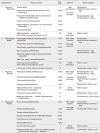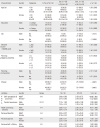Abstract
Purpose
This study was done to develop a Web-based preconception health promotion program to improve preconception health promotion awareness, perceived benefits, perceived self-efficacy and health behavior, and to reduce perceived barriers in couples about to be married.
Methods
Participants were assigned to the experimental group (n=26 couples) or control group (n=25 couples). This program was comprised of a six hour Web-based lecture series which was given to the experimental group over a four week period.
Results
Results for the two groups showed: 1) a significant difference in preconception health promotion awareness in men (self-perception: z=-3.62, p <.001 content: F=18.49, p <.001) and in women (self-perception: z=-2.89, p =.004 content F=36.93, p <.001), 2) a significant difference in perceived benefits in men (z=-3.09, p =.002), and in women (F=6.38, p =.004), 3) a significant difference in perceived barriers in men (F=3.64, p =.030), and in women (F=11.36, p <.001), 4) a significant difference in perceived self-efficacy in men (F=12.16, p <.001), but no significant difference in women (F=1.93, p =.166), 5) a significant difference in health promoting behavior in men (F=16.31, p <.001), and in women (F=10.99, p =.001).
Figures and Tables
Table 3
Differences between Groups in Preconception Health Promotion Awareness (self-perception awareness) and Perceived Benefits between Groups (N=102)

References
1. Statistics Korea. Final results of birth statistics in 2014 [Internet]. Daejeon: Author;2014. cited 2015 February 26. Available from: http://kostat.go.kr/portal/eng/pressReleases/8/10/index.board?bmode=read&aSeq=348278.
2. Ko HS, Park IY, Shin JC. Pre-pregnancy lifestyle of couple for a healthy pregnancy. J Korean Med Assoc. 2011; 54(8):825–831. DOI: 10.5124/jkma.2011.54.8.825.
3. Park MI. Importance of preconception care in low-fertility society of Korea. J Korean Med Assoc. 2011; 54(8):796–798. DOI: 10.5124/jkma.2011.54.8.796.
4. Delgado CE. Undergraduate student awareness of issues related to preconception health and pregnancy. Matern Child Health J. 2008; 12(6):774–782. DOI: 10.1007/s10995-007-0300-6.
5. Lee SR, Park JY, Ahn LS, Kim KY. Report No.: 2013-2-2. The status of preconceptional care and policy recommendations. Sejong: Korea Institute for Health and Social Affairs;2013.
6. Lee SR, Lim JY, Lee EJ, Cho YT, Ra CK.. Report No.: 2014-1-2. Preconception care and policy recommendations for unmarried women of childbearing age: Focusing on medical service use and online reproductive health information. Sejong: Korea Institute for Health and Social Affairs;2014.
7. Ahn S, Park I, Han JS, Kim TI, Kwak MS, Chung HS. Health behaviors, reproductive health history, and sexual behaviors of college students. Korean J Women Health Nurs. 2008; 14(3):205–212.
8. Pender NJ, Pender AR. Health promotion in nursing practice. . Stamford, CT: Appleton & Lange;1996. p. 1–320.
9. Je NJ, Choi SY. Study on awareness of preconception care and reproductive health behaviors in pre-honeymooners. Korean J Women Health Nurs. 2015; 21(2):71–82. DOI: 10.4069/kjwhn.2015.21.2.71.
10. Murray E. Web-based interventions for behavior change and self-management: Potential, pitfalls, and progress. Med 2 0. 2012; 1(2):e3. DOI: 10.2196/med20.1741.
11. Chung YC, Lee GH, Kim SJ, Yoo J. Report No.: 2010-39. 2010 Development and operation of gateway system for internet health information. . Seoul: Korea Institute for Health and Social Affairs;2010.
12. Wang HJ, Kim IO. Effects of a mobile web-based pregnancy health care educational program for mothers at an advanced maternal age. J Korean Acad Nurs. 2015; 45(3):337–346. DOI: 10.4040/jkan.2015.45.3.337.
13. Park MJ. Development of a web-based, tailored postpartum information program [master’s thesis]. Seoul: Yonsei University;2007. 1–95.
14. Chung HK, Song SH, Kang HK, Lee WH, Song SH, Kang NM. Application of the pregnancy, childbirth, breast-feeding UCC and web_based tailored pre-parental educational system among university students. J Korea Des Forum. 2012; 34:347–356.
15. Park MN, Choi SY. Development of reproductive health program and identification of effect for married women immigrants. J Korean Acad Nurs. 2014; 44(3):248–258. DOI: 10.4040/jkan.2014.44.3.248.
16. DeJoy SB. Pilot test of a preconception and midwifery care promotion program for college women. J Midwifery Womens Health. 2014; 59(5):523–527. DOI: 10.1111/jmwh.12106.
17. Choi YS. The development of web-based ventilator management education program. J Korea Acad Ind Coop Soc. 2012; 13(11):5284–5291. DOI: 10.5762/KAIS.2012.13.11.5284.
18. Faul F, Erdfelder E, Buchner A, Lang AG. Statistical power analyses using G*Power 3.1: Tests for correlation and regression analyses. Behav Res Methods. 2009; 41(4):1149–1160. DOI: 10.3758/brm.41.4.1149.
19. Moon JS. A study of instrument development for health belief of Korean adults [dissertation]. Seoul: Yonsei University;1990. 1–113.
20. Paek YM. Prediction model on health promotion behaviors in male office workers [dissertation]. Seoul: Ewha Womans University;2005. 1–129.
21. Sherer M, Maddux JE, Mercandante B, Prentice-Dunn S, Jacobs B, Rogers RW. The self-efficacy scale: Construction & validation. Psychol Rep. 1982; 51(2):663–671. DOI: 10.2466/pr0.1982.51.2.663.
22. Jo HY, Hae KY, Son HM. Development of a scale to measure reproductive health promoting behavior of undergraduates. Korean J Health Educ Promot. 2014; 31(5):29–43. DOI: 10.14367/kjhep.2014.31.5.29.
23. Agricola E, Pandolfi E, Gonfiantini MV, Gesualdo F, Romano M, Carloni E, et al. A cohort study of a tailored web intervention for preconception care. BMC Med Inform Decis Mak. 2014; 14:33–42. DOI: 10.1186/1472-6947-14-33.
24. Delgado C. Pregnancy 101: A call for reproductive and prenatal health education in college. Matern Child Health J. 2013; 17(2):240–247. DOI: 10.1007/s10995-012-0967-1.
25. Nam TW, Chung JY. A new paradigm for subject-oriented service system of university library. J Korean Libr Inf Sci Soc. 2003; 34(2):163–185.
26. Kim GH, Yoon HS. The effect of a health promotion program through multi-level health promotion. J Korean Acad Community Health Nurs. 2010; 21(1):92–100. DOI: 10.12799/jkachn.2010.21.1.92.
27. Park KY, Kim SH. The effects of breast self-examination program enriched environmentally among healthy women. Korean J Women Health Nurs. 2010; 16(2):105–115. DOI: 10.4069/kjwhn.2010.16.2.105.
28. Seo IJ, Park JS. Development and application of a health promotion program for marriage immigrant women. Korean J Adult Nurs. 2015; 27(2):198–210. DOI: 10.7475/kjan.2015.27.2.198.
29. Lee KJ, Chang CJ, Yoo JH. Effects of a health promoting education program on selfe-fficacy, knowledge of health management and health promoting behavior for middle-aged women. J Korean Community Nurs. 2004; 15(4):577–586.
30. Milan JE, White AA. Impact of a stage-tailored, web-based intervention on folic acid-containing multivitamin use by college women. Am J Health Promot. 2010; 24(6):388–395. DOI: 10.4278/ajhp.071231143.




 PDF
PDF ePub
ePub Citation
Citation Print
Print





 XML Download
XML Download